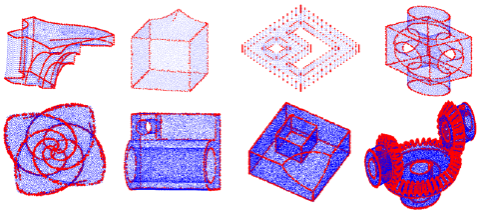Motivation
When reconstructing surfaces from scanned data, sharp features such as corners or ridges, e.g., from human-made objects, are challenging to detect but essential for good and faithful representation of the physical world.
Description
We will first utilize additional information from high-quality scanners, i.e., intensity - a product of reflectivity and angle - to compute the normals of points accurately to sensor device precision. Secondly, where not enough data from the scan is present to decide whether a ridge is a sharp feature or rounded off, we will learn this from appropriate patches.
Tasks (extent depends on PR/BA/DA)
- compute a reflectivity of points from the intensity [1] of several depth images in the scan and derive their angle [2] and thus the normal
- construct the sharp features from the points with normals
- add these sharp features to a mesh, reconstructed from the point cloud, e.g., Poisson Reconstruction [3]
- evaluate the results with a state-of-the-art algorithm [4,5]
[1] https://research.utwente.nl/files/329052960/rutzinger_ana.pdf
[2] https://www.mdpi.com/1424-8220/21/9/2960
[3] https://www.cs.jhu.edu/~misha/MyPapers/ToG13.pdf
[4] https://www.sciencedirect.com/science/article/pii/S0167839623000365
[5] https://www.sciencedirect.com/science/article/pii/S0010448522002019
Requirements
Python and C++ programming skills and interest in geometry processing and machine learning.
Environment
Platform-independent.
A bonus of €500/1,000 if completed to satisfaction within an agreed time frame of 6/12 months (PR/BA or DA).
